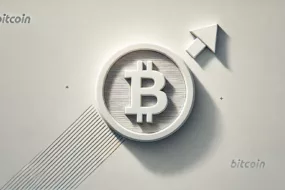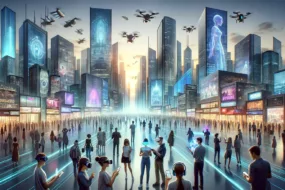
NFTs have taken the world by storm, with digital art selling for millions of dollars and capturing the attention of creators, collectors, and investors alike. But the potential of NFTs goes beyond the traditional art market. They can revolutionize how we think about ownership and value in the emerging realm of the metaverse.
As we explore the possibilities of this virtual world, NFTs have emerged as a critical tool for creators to claim their digital creations and for collectors to own unique and valuable pieces of the metaverse.
Moreover, we are just beginning to explore the role of NFTs in the metaverse, and the possibilities for this new form of ownership and creativity are endless.
What Is NFT?
NFTs (or Non-Fungible Tokens) are a new and exciting way of representing ownership of unique digital assets. They are based on blockchain technology, which allows for a secure and transparent verification of ownership and authenticity of digital assets.
The history of NFTs can be traced back to the early days of blockchain when Bitcoin first emerged as a decentralized digital currency.
NFTs can represent various digital assets, including art, music, videos, and more. They allow creators to monetize their digital creations by selling them as unique assets. The blockchain provides a transparent and secure way to verify and transfer ownership.
One of the most famous examples of NFTs is the digital artwork by ‘Beeple.’ It was sold for a record-breaking $69 million at a Christie’s auction in 2021. This artwork was represented by an NFT, which provided proof of ownership and authenticity to the buyer.
Other notable examples include the virtual lands in Decentraland, virtual racing cars in F1 Delta Time, and in-game items in Axie Infinity.
What Is Metaverse?
Metaverse is a virtual universe where people can interact with each other and digital objects in a fully immersive and interactive way. It’s like a massive, shared virtual reality that exists entirely online. The data within the Metaverse is vast, with endless possibilities for creating new experiences and interactions.
The concept of the Metaverse has been around for decades, with roots in science fiction literature called ‘Snow Crash.’
The idea behind the Metaverse is to create a seamless, interconnected digital world where people can do everything from working and learning to socializing and shopping. It’s a place where you can be and do whatever you want without the physical world’s limitations.
One example of the Metaverse in action is the massively popular online game ‘Fortnite.’ It is a prime example of how the Metaverse can unite people in a shared, virtual space.
Understanding the Role of NFTs in the Metaverse
In simple terms, NFTs can represent digital assets in the Metaverse.
For example, if you own a virtual piece of land in the Metaverse, you can represent that ownership with an NFT. Also, if you own a virtual item or clothing, you can showcase that ownership too with an NFT.
NFTs in the Metaverse allow for a new level of ownership and authenticity. They provide a way for people to own and authenticate their digital assets truly.
With the rise of the Metaverse, NFTs will become even more valuable and sought after.
Read on to further understand how NFTs play a crucial part in different types of metaverses.
NFTs and Gaming-Based Metaverse
A gaming-based metaverse is a virtual universe mainly focusing on gaming and interactive entertainment experiences.
These metaverses primarily employ gaming mechanics, enabling users to participate in quests, gameplay, and other challenges while exploring various virtual worlds.
A well-known example of a gaming metaverse is ‘Roblox.’
Below are the ways in which NFTs add value within the gaming metaverse ecosystem.
1. Ownership of In-Game Assets
NFTs can represent in-game assets like weapons, armor, skins, or virtual real estate.
Players can truly own their in-game assets and even trade them with others. Thus, this opens up new opportunities for players to monetize their gaming experience by selling their valuable in-game assets to other players who want to own them.
Moreover, NFTs can incentivize players to spend more time and money on games. So players who acquire rare or valuable in-game assets can show them off to their friends or even sell them for profit. Hence, this creates a new level of competition and motivation for players to invest in their gaming experience.
2. Liquidity
NFTs also offer a solution to the problem of asset liquidity in gaming.
In traditional games, players cannot sell their in-game assets for real money. But with NFTs, players can trade their assets on a decentralized cryptocurrency or fiat currency marketplace.
This means that players can quickly liquidate their assets if they need to or sell them for a profit.
NFTs and Commerce-based Metaverse
Decentralized marketplaces like ‘Decentraland’ are suitable examples of the commerce-based metaverse.
Decentralized marketplaces are online platforms operating on a blockchain network where users can buy and sell goods and services directly without intermediaries.
NFTs can be used to represent unique digital assets on these marketplaces. These assets include virtual real estate, digital art, collectibles, or music. By using NFTs, sellers can prove ownership and authenticity of their assets, increasing the value of their items.
Below are the ways in which NFTs add value within the commerce metaverse ecosystem.
1. Fractional Ownership
One of the significant advantages of NFTs in decentralized marketplaces is the potential for fractional ownership.
With NFTs, ownership can be divided into smaller parts, allowing multiple investors to invest in a single asset. This can help increase liquidity and make ownership more accessible to a larger audience.
2. New Revenue Stream
Using NFTs in decentralized marketplaces also offers opportunities for new revenue streams. Creators can sell their digital art or music directly to fans without the need for intermediaries like galleries or record labels.
This can result in higher profits for creators and a more direct relationship with their audience.
NFTs and Social-based Metaverse
A social-based metaverse enables social interaction, communication, and collaboration. These metaverses facilitate social connections, allowing users to meet new people and connect with friends and family.
One example of this type of metaverse is ‘Second Life.’
Below are the ways in which NFTs add value within the social metaverse ecosystem.
1. Enhanced Experience
Metaverse allows users to interact with other users in various virtual environments. It can act as a social hub with various activities and events to foster personal connections and community building.
Here, users can be encouraged to find and collect NFTs representing virtual items or characters. It adds an extra layer of immersion and interactivity to the social experience.
2. Advertising and Marketing
Brands can use NFTs to create unique and engaging experiences promoting products or services for their audiences.
For example, an NFT could represent a virtual shoe that can be placed and tried on in the metaverse.
NFTs and Education-based Metaverse
An education-based metaverse enhances educational experiences and opportunities for users.
It provides a virtual environment for students to attend classes, engage in group projects, and interact with instructors and other learners.
In this setup, NFTs can also be used to reward students for their achievements.
For example, a student who successfully completes a challenging task or assignment could be rewarded with an NFT representing their accomplishment. So this motivates students to do their best and gives them something tangible to prove their hard work.
Conclusion
NFTs could revolutionize how we think about digital assets in the Metaverse.
As more and more people enter virtual worlds, there will be an increasing demand for unique, valuable, and collectible digital items. NFTs solve this demand, allowing creators to monetize their digital creations and buyers to own and showcase their virtual assets truly.
Furthermore, NFTs open up a world of possibilities for artists, musicians, and creators who can now earn a living from their work in virtual spaces.
As the Metaverse continues to evolve and expand, we expect to see a growing market for NFTs and other digital assets.
FAQs
1. What are NFTs, and how do they work in the metaverse?
NFTs are unique digital assets using blockchain technology to verify ownership and authenticity.
In the metaverse, NFTs can represent virtual assets, including digital art, virtual real estate, and in-game items, that users can own, trade, and sell.
2. Can NFTs be used in other applications besides gaming?
Yes, you can use NFTs in other applications besides gaming, including art, music, collectibles, and more.
They offer a new level of ownership and authenticity to digital assets. They can be used in various industries to create new revenue streams and enhance the user experience.
3. How can NFTs contribute to a more decentralized ecosystem in the metaverse?
NFTs can contribute to a more decentralized ecosystem in the metaverse. It allows users to own and control their virtual assets, reducing the need for intermediaries and creating a more open and transparent market.
NFTs also offer greater liquidity and fractional ownership, making it easier for more users to participate in the market.





